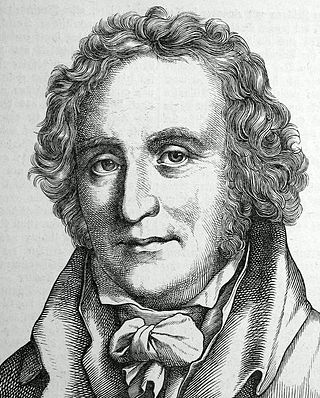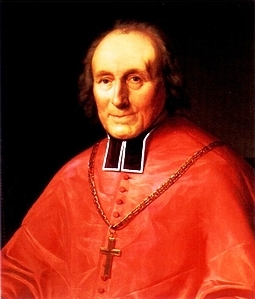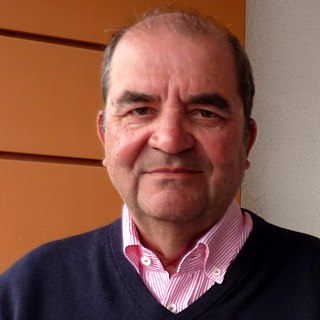
Boniface was an English Benedictine monk and leading figure in the Anglo-Saxon mission to the Germanic parts of Francia during the eighth century. He organised significant foundations of the church in Germany and was made bishop of Mainz by Pope Gregory III. He was martyred in Frisia in 754, along with 52 others, and his remains were returned to Fulda, where they rest in a sarcophagus which remains a site of Christian pilgrimage.

Friedrich Leopold Graf zu Stolberg-Stolberg, was a German lawyer, and translator born at Bramstedt in Holstein. He was also a poet of the Sturm und Drang and early Romantic periods.
The Concilium Germanicum was the first major Church synod to be held in the eastern parts of the Frankish kingdoms. It was called by Carloman on 21 April 742/743 at an unknown location, and presided over by Boniface, who was solidified in his position as leader of the Austrasian church. German historian Gunther Wolf judges that the Concilium was the high point in Boniface's long career.

Baron Clemens August Droste zu Vischering was an Archbishop of Cologne. His clashes with the Prussian government were characteristic of the conflict between the Catholic church and the Prussian-Protestant state power in 19th-century Germany.

The Catholic Diocese of the Old Catholics in Germany is the German member body of the Union of Utrecht of Old Catholic Churches, which follow Ultrajectine theology. It is permitted to levy the German church tax on its members. Its episcopal see is in Bonn, as is its theological faculty. Its membership is concentrated around Cologne, Bonn, the Ruhr and southern Baden. The bishop of the diocese is Matthias Ring.
Heribert Mühlen was a German Roman-Catholic theologian.
The Vicariate Apostolic of Northern Germany, known for most of its existence as the Vicariate Apostolic of the NorthernMissions, was a Catholic missionary jurisdiction established on 28 April 1667. It belonged to a vicar apostolic in predominantly Protestant Northern Europe.
Moritz Joseph Josias Lieber was a German Catholic politician and publisher. He was a translator of many conservative and Catholic authors into German, including Joseph de Maistre and Thomas More. He was the first president of the "Katholische Verein Deutschlands", which would become the forerunner of the Catholic association, particularly the Centre Party.

Johannes von Geissel was a German Catholic Archbishop of Cologne and Cardinal from the Electorate of the Palatinate.

Count Christian Frederick of Stolberg-Wernigerode was the only son of Count Henry Ernest of Stolberg-Wernigerode, whom he succeeded as ruler of the County of Wernigerode in 1778.

Prince William Maurice of Nassau-Siegen, German: Wilhelm Moritz Fürst von Nassau-Siegen, official titles: Fürst zu Nassau, Graf zu Katzenelnbogen, Vianden, Diez, Limburg und Bronkhorst, Herr zu Beilstein, Stirum, Wisch, Borculo, Lichtenvoorde und Wildenborch, Erbbannerherr des Herzogtums Geldern und der Grafschaft Zutphen, was a count from the House of Nassau-Siegen, a cadet branch of the Ottonian Line of the House of Nassau. He served as an officer in the Dutch States Army. In 1664, he was elevated to the rank and title of prince. In 1679, he became Fürst of Nassau-Siegen, a part of the County of Nassau.

Ulrich Vogt is a German educator and author.
Lutz E. von Padberg is a German historian whose specialty is medieval history and in particular the Christianization of the Germanic peoples. He is an expert on Saint Boniface, having written biographies of the saint and studies of his veneration.

The Ragyndrudis Codex is an early medieval codex of religious texts, now in Fulda in Germany, which is closely associated with Saint Boniface, who according to tradition used it at the time of his martyrdom to ward off the swords or axes of the Frisians who killed him on 5 June 754 near Dokkum, Friesland. This long association has given the codex the status of a contact relic.
The Catholic Integrated Community (CIC) was an apostolic community within the Roman Catholic Church according to Decree Apostolicam actuositatem No. 18/19 of the Second Vatican Council. It was recognized by the church in several dioceses in Germany, Austria, Italy and Tanzania,. After an investigation of the community by the Archdiocese of Munich and Freising, Munich Archbishop Cardinal Reinhard Marx dissolved it under canon law in November 2020. In the meantime, most of the German dioceses followed suit and also dissolved the integrated communities.
Rudolf Johannes Pesch was a German Catholic theologian.
The Deutscher Musikrat is an umbrella organization for music associations and the 16 music councils of the German federal states. It represents over 14 million music-loving citizens who, for professional reasons or as amateurs, are affiliated with the Musikrat and its member organizations. With more than 100 member associations, institutions and numerous personalities, it acts, together with its projects and support measures, as an advisor and competence centre for politics and civil society.

Baron Ferdinand Wilhelm Adolf Franz von Plettenberg, lateron Count von Plettenberg und Wittem, commonly referred to as Ferdinand von Plettenberg, born July 25, 1690, in Paderborn, died March 18, 1737, in Vienna was Prime Minister of the Electorate of Cologne, Treasurer and Hereditary Marshal of Prince-elector Clemens August of Bavaria and an important supporter of Maria Theresa in the succession to the throne for the Habsburgian Erblande.

Count John II of Waldeck-Landau, German: Johann II. Graf von Waldeck-Landau, official titles: Graf zu Waldeck und Pyrmont, Herr zu Tonna, was since 1638 Count of Waldeck-Landau. He served in the Swedish Army.
Maria Birgitta zu Münster, OSB : née Ursula zu Münster, was a Catholic convert, Benedictine nun, and translator.











